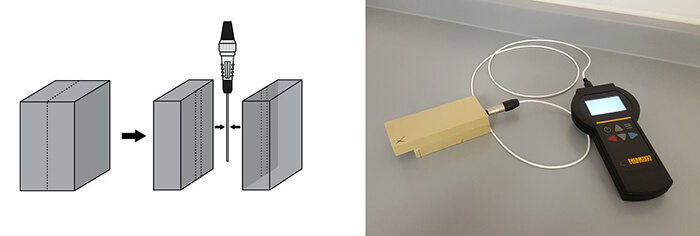Join us at the International Thermal Conductivity Conference (ITCC) and the International Thermal Expansion Symposium (ITES).
February 16, 2024
May 4, 2021
September 26, 2019
May 25, 2021
October 30, 2019

July 20, 2016
This month in the Thermtest lab, the TLS-100 was used to measure the thermal conductivity and thermal resistivity of two materials, steatite and bisque fired alumina. Both of these materials are widely used in industrial applications, and are popular due to their heat resistive properties and insulating natures. The TLS-100 is Thermtest’s portable thermal conductivity and resistivity meter, and is an excellent choice for convenient, accurate thermal conductivity testing in both the lab and the field. It performs measurements in accordance with ASTM D5334 – Standard Test Method for Determination of Thermal Conductivity of Soil and Soft Rock by Thermal Needle Probe Procedure.
The TLS-100 completes measurements using the attached needle probe, which acts as both the heating element and temperature sensor. Thermal paste is often used with solid samples to achieve maximum contact between the sensor and sample. For this testing procedure, two pieces of each material were obtained and the thermal needle was sandwiched between the two pieces after being coated with thermal paste (Figure 1). A 15 minute wait period was observed prior to beginning measurements to ensure the sample and sensor were isothermally stable. A measurement schedule was then initiated, consisting of 5 tests of 120 seconds each spaced 15 minutes apart.

Figure 1. The diagram on the left illustrates the method used to ensure excellent thermal contact between the needle probe of the TLS-100 and the material samples. The photo on the right depicts the two samples of bisque fired alumina during testing.
Table 1 summarizes the results of the thermal conductivity and thermal resistivity testing of these materials. The results of each test show remarkable similarity to each other, a testament to the precision of the TLS-100 system. The mean thermal conductivity of steatite and bisque fired alumina were 3.107 and 5.077 W/mK respectively, both of which correspond to the accepted reference thermal conductivity values of 3 and 5-5.25 W/mK for these materials.
| Bisque Fired Alumina | Steatite | ||||
| Test # | Thermal Conductivity (W/mk) | Thermal Resistivity (mK/W) | Test # | Thermal Conductivity (W/mK) | Thermal Resistivity (mK/W) |
| 1 | 5.005 | 0.199 | 1 | 3.098 | 0.322 |
| 2 | 4.953 | 0.201 | 2 | 3.076 | 0.325 |
| 3 | 5.137 | 0.194 | 3 | 3.203 | 0.312 |
| 4 | 5.181 | 0.192 | 4 | 3.085 | 0.324 |
| 5 | 5.108 | 0.195 | 5 | 3.075 | 0.325 |
| Mean | 5.077 | 0.196 | Mean | 3.107 | 0.322 |